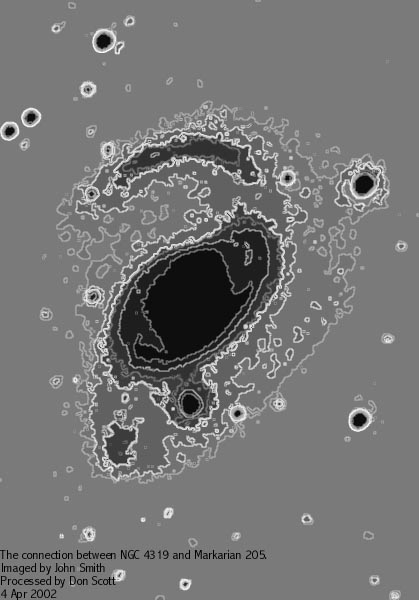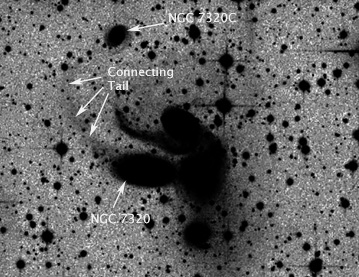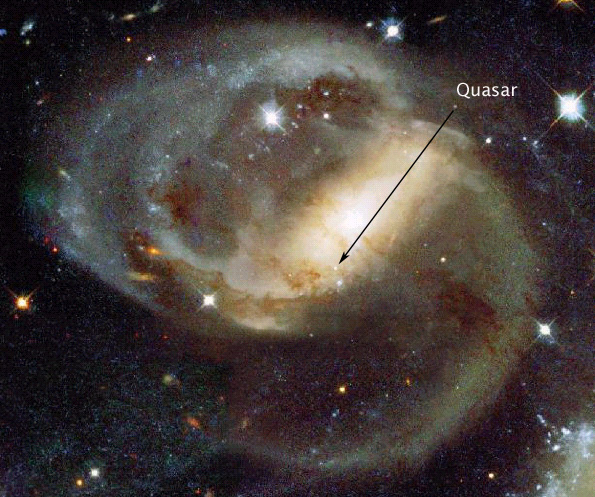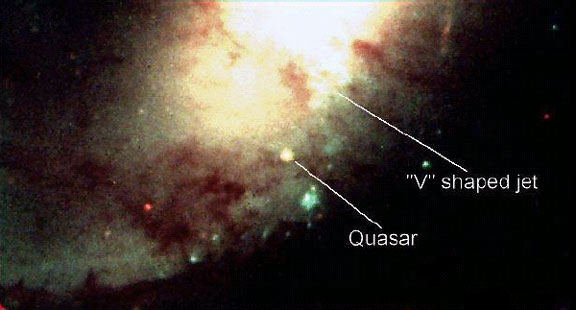|
If the lines in the spectrum of the light from a star or galaxy appear at a lower frequency (shifted toward the red) than where they are observed in the spectrum of the Sun, we say this object exhibits 'positive redshift'.
The accepted explanation for this effect is that the object must be moving away from us.
This interpretation is drawn by analogy with the downward shift in the pitch of a train whistle as it passes through a railroad crossing and then speeds away from us.
The question is:
It has become clear that the answer to that question is an
emphatic NO!
The
simple interpretation of this is to say that this object must
therefore be receding from us at 56% of the speed of light or 0.56 x
300,000 km/sec. Mainstream astrophysicists believe that recessional
velocity, v = cz. This object, therefore, must be very far away from
Earth.
He has earned the Helen B.Warner prize, the Newcomb Cleveland award and the Alexander von Humboldt Senior Scientist Award. For years he worked at the Mt. Palomar and Mt. Wilson observatories.
While there, he developed his
well known catalog of "Peculiar Galaxies" that are misshapen or
irregular in appearance.
Arp has photographs of many pairs of high redshift quasars that are symmetrically located on either side of what he suggests are their parent, low redshift galaxies.
These pairings occur much more often than the probabilities of random placement would allow. Mainstream astrophysicists try to explain away Arp's observations of connected galaxies and quasars as being "illusions" or "coincidences of apparent location".
But, the large number of physically associated
quasars and low red shift galaxies that he has photographed and
cataloged defies that evasion. It simply happens too often
The Big Bang
theory is therefore falsified.
A prime example of Arp's challenge is the connected pair of objects
NGC 4319 and Markarian 205.
This connection is between two objects that have vastly different redshift values. Mainstream astronomers deny the existence of this physical link.
They claim these two objects are not close together - they are 'coincidentally aligned'.
On April 4, 2002 amateur astronomer John Smith of Oro Valley, AZ obtained an image of the two objects.
The author of these pages then quantized that image to show isophote contours (of equal brightness). This result is shown below. The isophotes in the central section of 4319 suggest that the galaxy is indeed a barred spiral. Also the main arms seem to be coming off at their roots.
Both of these observations were first noted by Arp and stated as such in his book.
Notice that only Mark 205's isophotes are stretched back toward NGC 4319. None of the other objects in close proximity to 4319 are distorted in this manner.
Then on October 7, 2002 the Astronomy Picture of the Day issued a Hubble Space Telescope image of these same objects. The orientation is different.
After processing this HST image in the same way as the above amateur image, the following were obtained:
(a) (b)
Notice, in the magnified isophote view, (b), that there is a distention of the shape of the Mark 205 inner isophotes back toward NGC 4319. There are also a series of secondary masses within Mark 205 on a line connecting 4319 and the center of Mark 205.
But NASA scientists 'cannot see any connection between these two objects.'
The official explanation of the NASA image states,
Professional astronomers seem to be so enamored of their 'redshift
equals distance' theory that it damages their eyesight.
In "Quasars, Redshifts, and Controversies" (p. 96-101) Halton Arp discusses the five interacting galaxies NGC 7317, 7318A, 7318B, 7319, and 7320 that constitute Stephan's Quintet.
The last one, NGC 7320, has a redshift value of 800 km/sec.
The other four have redshifts of either 5700 km/sec or 6700 km/sec. Mainstream
astronomers therefore claim those last four are about eight times
farther away from us than NGC 7320. Therefore, they say, there
cannot be any interaction between 7320 and the others.
He points out,
He then states that at least one amateur has been able to see the
tail but, "it is amazing that so many professionals have difficulty
seeing it." NASA routinely crops their images of Stephan's Quintet
to exclude the area where this tail would be seen.
The large, dark galaxy on the left is the low redshift NGC 7320. Then going counter-clockwise we have 7317, 7318A, 7318B, and 7319. At the top of the image is the small galaxy NGC 7320C.
After some digital image processing (which only increased contrast), the result shown below was obtained.
It is apparent that a 'tail' does indeed extend out from NGC 7320 toward the left.
In fact it appears to curve around and connect to
the small galaxy NGC 7320C. The redshift of this small companion
galaxy is z = 0.02 which is about 10 times that of NGC 7320.
Arp believes that the observed redshift value of any object is made up of two components: the inherent component and the velocity component.
The velocity component is the only one recognized by mainstream astronomers. The inherent redshift is a property of the matter in the object. It apparently changes over time in discrete steps. He suggests that quasars are typically emitted from their parent galaxies with inherentiredshift values of up to z = 2.
They continue to move away, with stepwise decreasing inherent redshift. Often, when the inherent redshift value gets down to around z = 0.3, the quasar starts to look like a small galaxy or BL Lac object and begins to fall back, with still decreasing redshift values, toward its parent. He has photos and diagrams of many such family groupings.
Any additional redshift (over and above its inherent
value) is indeed indicative of the object's velocity. But the
inherent part is an indication of the object's youth and usually
makes up the larger fraction of a quasar's total redshift.
The very existence of this quantization alone, is sufficient proof of the failure of the idea that redshift is only an indicator of recessional speed (and therefore distance).
This quantization means
(under the redshift equals distance interpretation) that quasars all
must lie in a series of concentric shells with Earth at the center
of the entire arrangement. Copernicus found out a long time ago that
Earth isn't at the center of anything!
One would at least expect the "powers that be" to immediately turn the Chandra X-ray orbiting telescope, the Hubble space telescope, and all the big land based telescopes toward Arp's exciting discoveries in order to either confirm or disprove them once and for all. Instead, these objects have been completely excluded from examination. Official photographs are routinely cropped to exclude them.
Those familiar with the
Galileo story will remember the priests who refused to look through
his telescope.
The final irrefutable falsification of the "Redshift equals distance" assumption is the following image of galaxy NGC 7319 (Redshift = 0.0225). The small object indicated by the arrow is a quasar (Redshift z = 2.11)
This observation of a quasar between the galaxy and Earth is impossible if the quasar is over ninety times farther away than the galaxy.
In fact, a higher magnification image of the quasar (below) shows a "jet" of matter extending out from the center of NGC 7319 toward the quasar.
So, Arp is correct in his contention that redshift is caused mainly by an object's being young, and only secondarily because of its velocity.
Therefore, quasars are not the brightest, most distant and
rapidly moving things in the observed universe - but they are among
the youngest.
The Big Bang Theory is false - not because I or others claim it to
be false - but because it has been scientifically falsified.
Occasionally he returns to the United States to give lectures and visit family.
|
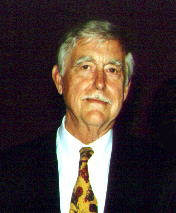 Halton Arp
Halton Arp

